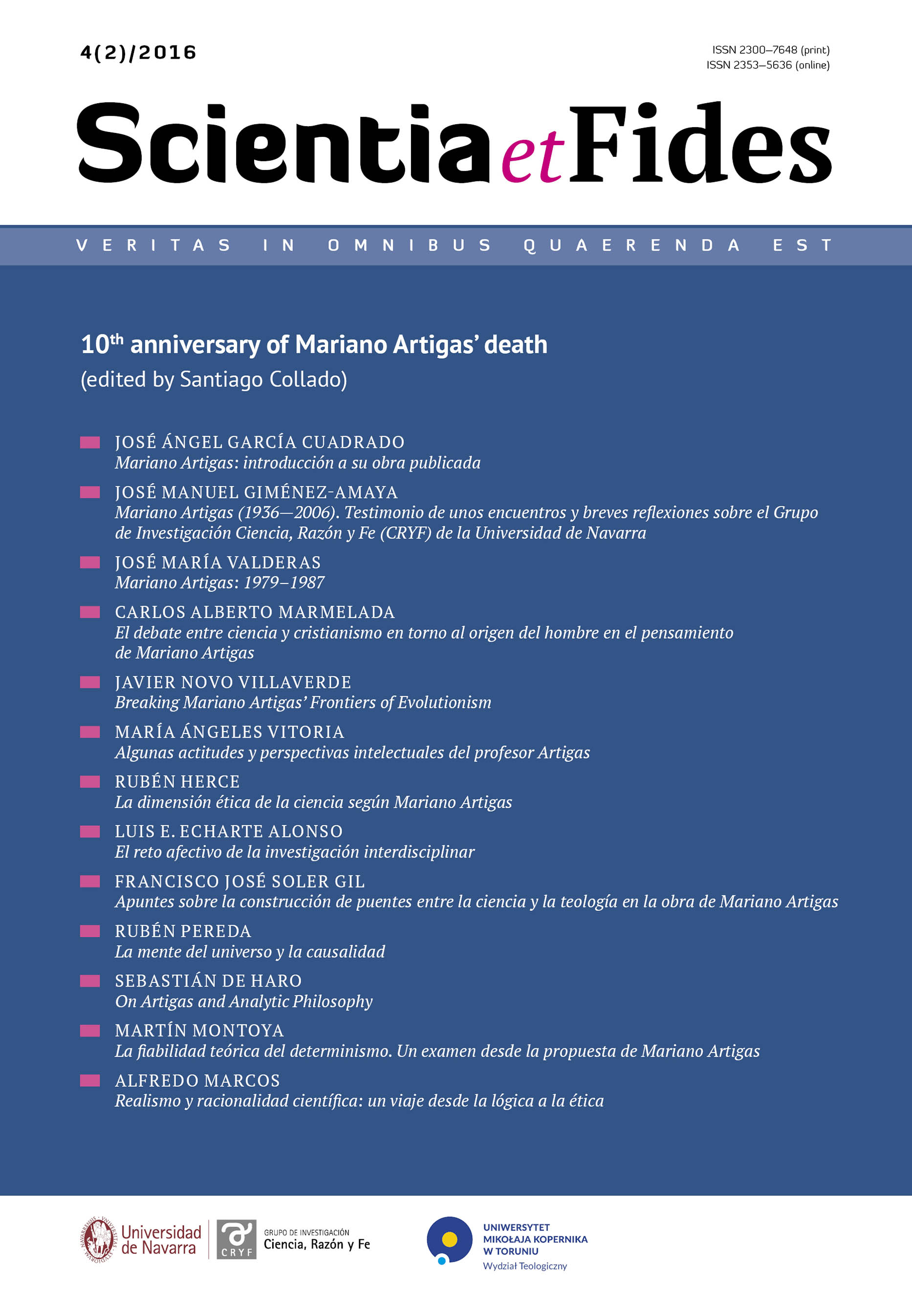Neurobiology and free will: a dialogue between Mariano Artigas and John Eccles
Słowa kluczowe
interdisciplinarity, mind-brain, reductionism, free willAbstrakt
In this article, I discuss the importance of multidisciplinary research to tackle the questions that empirical sciences, and in particular neuroscience, ultimately encounter. The last decades have witnessed an enormous progress in brain research, mainly because of the improvement of neuroimaging techniques and neurogenetics, and the development of optogenetics. Furthermore, the US Government and European Union have launched the BRAIN Initiative and Human Brain Project, respectively, to promote a better understanding of brain functioning and its disorders. Unfortunately, their gates appear sealed for disciplines that pursue a deep knowledge of the mind, such as philosophy or psychology. The most probable outcome of this situation is “promissory materialism”, as Sir John Eccles warned several decades ago. I review the multidisciplinary approach of Eccles to the study of the brain and mind, especially through his relationship with Mariano Artigas. Finally, I propose that interdisciplinary research may be improved by a more solid understanding of the discipline one wants to dialogue with, and a multidisciplinary training from the beginning of the research career.
Bibliografia
Artigas, M. 2004. Las fronteras del evolucionismo. Pamplona: Eunsa.
Artigas, M., and J. C. Eccles. 2004. “Alma humana, ciencia, religión.” In Las fronteras del evolucionismo. Pamplona: Eunsa.
Bennett, M. R., and P. M. S. Hacker. 2003. Philosophical Foundations of Neuroscience. Oxford: Blackwell Publishing.
Bernacer, J., and J. M. Giménez-Amaya. 2013. “On Habit Learning in Neuroscience and Free Will.” In Is Science Compatible with Free Will?, edited by A. Suarez and P. Adams, 177–193. New York: Springer. doi:10.1007/978-1-4614-5212-6.
Blackmore, S. 2007. “Mind over Matter?” The Guardian - Medical Research (Opinion). https://www.theguardian.com/commentisfree/2007/aug/28/mindovermatter.
Bush, G. 1990. “Project of the Decade of the Brain.” Presidential Proclamation 6158. http://www.loc.gov/loc/brain/proclaim.html.
Calderone, J. 2014. “10 Big Ideas in 10 Years of Brain Science.” Scientific American Mind. http://www.scientificamerican.com/article/10-big-ideas-in-10-years-of-brain-science/.
Eccles, J. C. 1943. “The Ionic Mechanism of Postsynaptic Inhibition.” In Nobel Lecture. Stockholm.
Eccles, J. C. 1965. The Brain and the Unity of Conscious Experience. Cambridge: Cambridge University Press.
Eccles, J. C. 1970. Facing Reality: Philosophical Adventures of a Brain Scientist. New York: Springer Verlag.
Eccles, J. C., and D. N. Robinson. 1984. The Wonder of Being Human. London: Collier Macmillan.
Hyman, S. E. 1998. “NIMH during the Tenure of Director Steven E. Hyman, M.D. (1996-Present): The Now and Future of NIMH.” American Journal of Psychiatry 155(9 Suppl): 36–40.
Libet, Benjamin. 1985. “Unconscious Cerebral Initiative and the Role of Conscious Will in Voluntary Action.” Behavioral and Brain Sciences 8:529-566. doi:10.1017/S0140525X00044903.
Libet, B., C. A. Gleason, E. W. Wright, and D. K. Pearl. 1983. “Time of Conscious Intention to Act in Relation to Onset of Cerebral Activity (Readiness-Potential).” Brain 106:623–642.
Miller, G. A. 2010. “Mistreating Psychology in the Decades of the Brain.” Perspectives on Psychological Science 5(6):716–743. doi:10.1177/1745691610388774.Mistreating.
Murillo, J. I., and J. M. Giménez-Amaya. 2008. “Tiempo, conciencia y libertad: Consideraciones en torno a los experimentos de B. Libet y colaboradores.” Acta Philosophica 11(17):291–306.
Schultze-Kraft, M., D. Birman, M. Rusconi, C. Allefeld, K. Görgen, S. Dähne, B. Blankertz, and J. D. Haynes. 2015. “The Point of No Return in Vetoing Self-Initiated Movements.” Proceedings of the National Academy of Sciences 113(4):1080–85. doi:10.1073/pnas.1513569112.
Pobrania
Opublikowane
Jak cytować
Numer
Dział
Licencja
CC BY ND 4.0. Posiadaczem prawa autorskiego (Licencjodawcą) jest Autor, który na mocy umowy licencyjnej udziela nieodpłatnie prawa do eksploatacji dzieła na polach wskazanych w umowie.
- Licencjodawca udziela Licencjobiorcy licencji niewyłącznej na korzystanie z Utworu/przedmiotu prawa pokrewnego w następujących polach eksploatacji: a) utrwalanie Utworu/przedmiotu prawa pokrewnego; b) reprodukowanie (zwielokrotnienie) Utworu/przedmiotu prawa pokrewnego drukiem i techniką cyfrową (e-book, audiobook); c) wprowadzania do obrotu egzemplarzy zwielokrotnionego Utworu/przedmiotu prawa pokrewnego; d) wprowadzenie Utworu/przedmiotu prawa pokrewnego do pamięci komputera; e) rozpowszechnianie utworu w wersji elektronicznej w formule open access na licencji Creative Commons (CC BY-ND 3.0) poprzez platformę cyfrową Wydawnictwa Naukowego UMK oraz repozytorium UMK.
- Korzystanie przez Licencjobiorcę z utrwalonego Utworu ww. polach nie jest ograniczone czasowo ilościowo i terytorialnie.
- Licencjodawca udziela Licencjobiorcy licencji do Utworu/przedmiotu prawa pokrewnego nieodpłatnie na czas nieokreślony
PEŁEN TEKST UMOWY LICENCYJNEJ >>
Statystyki
Liczba wyświetleń i pobrań: 539
Liczba cytowań: 0



